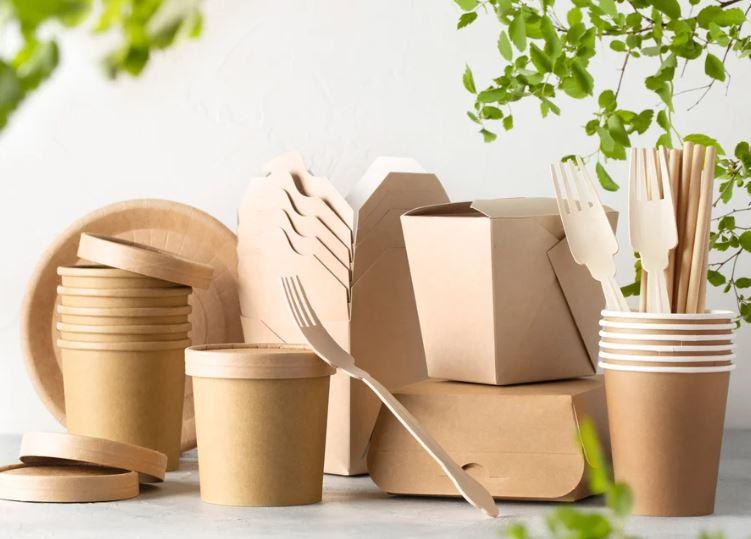As consumers who are concerned about the environment demand more environmentally friendly products, businesses that deal in food and beverages are adjusting their practices by adopting sustainable packaging solutions. In this article, the top eight trends that are transforming the industry are discussed. Important Developments in Eco-Friendly PackagingMaterial that can be compostedBiodegradable plastics Packaging that is biodegradablePackaging that is recyclableBags That Can Be Used AgainThe Optimization of PackagesEnvironment-Friendly Materials for ShippingEco-Friendly Packaging for Pet Food SourcesPackaging that is compostable Compostable packaging is packaging that can be broken down into natural material rather than being thrown away in landfills. Nevertheless, not all plastics that can be composted are created equal. Household compostable packaging can be broken down in backyard compost heaps, while some types of compostable materials packaging require industrial composting facilities. You should look for products that have been certified by recognized standards such as OK Compost Home or the standard established by the Australasian Bioplastics Association in order to guarantee that they are truly compostable. Biodegradable plasticsInstead of being derived from fossil fuels, bioplastics are made from biomass from sources such as corn and sugarcane. Compared to traditional plastics, they generate a significantly lower amount of emissions that contribute to the greenhouse effect.
It should be noted, however, that not all bioplastics are actually biodegradable
- Before choosing bioplastic packaging, it is important to conduct thorough research on the sustainability claims made by manufacturers
- Packaging that is biodegradableAlthough "biodegradable" is a buzzword that is extremely popular, this term can be misleading
- There are some plastics that are supposedly biodegradable, but it takes them years to decompose and they only break down into microplastics
- Choose a packaging material that can be broken down into biomass, gas, or water within a year and biodegrades within that time frame
- Objects That Can Be RecycledPackaging materials such as aluminum, glass, and plastics #1 and #5 can be converted into new products on an ongoing basis if they are designed with the ability to be recycled in mind
- However, recycling rates differ from region to region due to factors such as local waste management programs
- When selecting packaging that can be recycled, it is important to make sure that your region has the machinery necessary to recycle it
- Bags That Can Be Used AgainIt is possible to eliminate waste through the use of reusable packaging because it can be reused in its original form
- Materials that are long-lasting, such as stainless steel, glass, and thick plastic, are able to withstand different applications
The implementation of reusability is being investigated by businesses in a variety of innovative ways, including subscription services, discount incentives, and other methods. It is almost always the case that reuse has a lower impact on the environment than even recyclable recyclable disposable packaging.
A smaller environmental footprint can be achieved by using less material for packaging. Packaging can be optimized through the use of techniques such as reducing the weight of the package, minimizing the amount of filler, thinning the walls, and removing excess plastic, paper, or glass. However, make sure that the protection of the product is not compromised. Packaging that is optimized can reduce the amount of fuel used as well as the costs of the materials used. Environment-Friendly Materials for ShippingShipping materials such as bubble wrap and packing peanuts are examples of materials that generate waste in addition to the packaging that was used to hold the products. These are items that are not accepted by many recyclers. The use of biodegradable packing peanuts, recycled paper cushioning, and plant-based padding materials are all examples of environmentally friendly alternatives. A further reduction in the carbon footprint of deliveries can be achieved by selecting environmentally friendly shipping materials.
Eco-Friendly Packaging for Pet Food SourcesPet food manufacturers now offer environmentally friendly packaging options in response to the growing demand from customers for sustainable products. Pet parents are able to reduce the amount of waste they produce by using compostable materials packaging, recyclable materials, and renewable bioplastics. Recycling programs that are innovative also have the goal of reusing plastics in new pet products. Just like with human foods, the most environmentally friendly solution is to use reusable containers for pet food. Food and beverage companies have the ability to satisfy the demand of their customers for sustainable products while simultaneously contributing to a healthier planet by adopting these trends in packaging that are focused on compostability, renewability, recyclability, and reuse.
